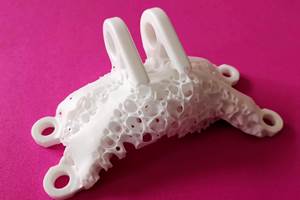Updated nTop Platform Advances AM Design, Simulations
The updated design and simulation solution builds upon nTop's core technologies and introduces new capabilities across four key themes — design, integration, scaling and adoption.
Share
The company’s nTop 4 offers a holistic approach to design for additive manufacturing (DfAM), enabling engineers to deliver highly engineered AM parts for products to reach new levels of performance. Photo Credit: nTop
Engineering design software company nTop (formerly nTopology) has updated its flagship design and simulation solution to offer nTop 4. With a holistic approach to design for additive manufacturing (DfAM), nTop 4 is said to enable engineers to bring additive manufacturing (AM) to mainstream production. This release builds upon nTop’s core technologies and introduces new capabilities across four key themes — design, integration, scaling and adoption.
“At nTop, we have always believed that design is at the core of solving the world’s hardest engineering problems,” says Bradley Rothenberg, nTop co-founder and CEO. “nTop 4 marks the next stage of our journey, enabling engineers to deliver highly engineered AM parts for products to reach new levels of performance.”
The nTop 4’s Field Optimization is a generative design technology that helps engineers navigate the overwhelming number of design parameters introduced by complex engineering problems, accelerating decision-making and improving part performance. This feature layers a multiscale and multi-objective optimization engine on top of nTop’s core technology, resulting in a design tool that is both powerful and easy to implement, the company says.
The Field Optimization feature also introduces easy-to-use workflows enabling engineers to generate better-performing AM part designs for applications such as lightweighting, medical implants and industrial design. The company says it will continue developing capabilities of this new technology in future releases.
The integration element is said to eliminate data exchange bottlenecks with Implicit Interop. The Implicit Interop function is said to eliminate data exchange bottlenecks for even the most complex designs, enabling data transfer between nTop, manufacturing, CAD and CAE software in files sizing in the megabytes, not gigabytes.
The nTop 4 also includes nTop Core which is a developer library that makes it easy for partners to implement native Implicit Interop integrations and is already in use by nTop’s partner ecosystem. The nTop plugin for EOSPrint is the first Implicit Interop software connection which will be available with the upcoming release of EOSPrint 2.14 in June. The nTop Implicit File (.implicit) is an nTop file format used to directly exchange implicit geometry without meshing, resulting in smaller file sizes at lossless precision.
The nTop Automate enables users to multiply the impact of engineering resources by executing nTop workflows through a programmatic environment. In addition to the Windows deployment, nTop 4’s nTop Automate for Linux enables engineers to unlock more economical cloud computing or use available on-premise high-performance computing (HPC) resources.
The company is also looking to create value faster with its customer success programs to accelerate adoption and maximize impact in organizations of any size. The nTop Accelerate offers a range of one-to-one training services, custom workshops and design sprints to help nTop’s customers best meet their program objectives. The company also continues to invest in onboarding programs — such as nTop Learn, nTop’s online learning center — to ensure that engineers can deliver value as fast as possible.
- Learn more about nTop’s platform which offers a design and simulation solution for design, simulation and advanced manufacturing processes.
- Read about nTop’s 3.0 version of its AM Engineering Design solution that offers an opt-in feature enabling nTop users to experience an instant 10 to to 100 times performance boost when visualizing workflows that use complex field-driven geometry.
- Check out this article about Stratasys and nTopology’s fixture software that simplifies AM modeling and design. The FDM Assembly Fixture Generator automates design of jigs and fixtures, enabling engineers to quickly turn a part file into a ready-to-print fixture with a simple drag-and-drop function.
Related Content
Taking the Leap into Additive Manufacturing
SolidCAM’s partnership with Desktop Metal, and its in-depth experience in combined metal 3D printing and CNC finishing, is aimed at making additive manufacturing accessible and profitable for job shops and other manufacturers.
Read MoreActivArmor Casts and Splints Are Shifting to Point-of-Care 3D Printing
ActivArmor offers individualized, 3D printed casts and splints for various diagnoses. The company is in the process of shifting to point-of-care printing and aims to promote positive healing outcomes and improved hygienics with customized support devices.
Read MoreImplicit Modeling for Additive Manufacturing
Some software tools now use this modeling strategy as opposed to explicit methods of representing geometry. Here’s how it works, and why it matters for additive manufacturing.
Read MoreSpherene Creates Metamaterial with Geometry Derived from Spheres
An algorithm developed by Spherene Inc. generates Adaptive Density Minimal Surfaces (ADMS) as a self-supporting infill strategy that can be used to reduce mass and manage material properties in 3D printed parts.
Read MoreRead Next
3D Printing Brings Sustainability, Accessibility to Glass Manufacturing
Australian startup Maple Glass Printing has developed a process for extruding glass into artwork, lab implements and architectural elements. Along the way, the company has also found more efficient ways of recycling this material.
Read MoreHybrid Additive Manufacturing Machine Tools Continue to Make Gains (Includes Video)
The hybrid machine tool is an idea that continues to advance. Two important developments of recent years expand the possibilities for this platform.
Read More4 Ways the Education and Training Challenge Is Different for Additive Manufacturing
The advance of additive manufacturing means we need more professionals educated in AM technology.
Read More













.png;maxWidth=300;quality=90)










